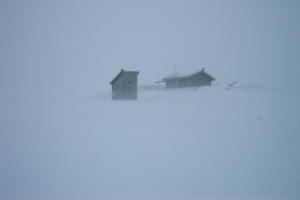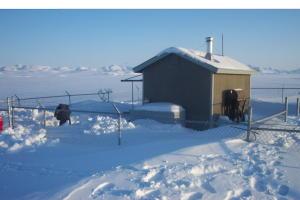12 April, 2002
Answers from yesterday's MagnaProbe averages:
short Shrubs: 59.9454
stream channel: 77.4112
tall shrubs: 89.3446
tundra: 19.1158
trees: 114.03
What is the relationship between vegetation type and snow depth??
Looking at the GPS/MagnaProbe data, as the vegetation size increases, the
snow depth increases. The vegetation traps the snow, preventing it from
being blown away by the wind. The wind blows often on the tundra causing
the snow to blow away and be deposited elsewhere. Adding taller and taller
shrubs and/or trees to the arctic tundra causes more and more snow to be
trapped. If we list the vegetation types above in terms of their heights
(shortest to tallest), we get: tundra, short shrubs, tall shrubs, and
trees. This progression directly corresponds to the increases in snow
depths that we have measured during our traverse.
This snow acts as a warm blanket, insulating the ground. This warmth can
cause further tall vegetation growth. There is some concern that the
Arctic climate is gradually becoming warmer. If this is so, there will be
a change in the vegetation. The vegetation will become taller. Traveling
through the Brooks Range has brought us to new terrain. There is no longer
large shrubs and trees. This is the Arctic where vegetation is few and
limited. There are mostly only sparce, small shrubs.
WHERE IS MRS. CHEUVRONT???? LET'S PLOT!!!!
Latitude: 68.48202 degrees North
Longitude:155.75247 degrees West
Ivotuk. We have arrived at Ivotuk, a small research cabin sitting at the
edge of the Brooks Range Mountains. This cabin is very isolated; it exists
hundreds of miles in any direction from human civilization. The research
cabin is mainly used by groups of scientists in the summertime. Few
venture to such a place in the winter. The cabin is small but pleasantly
cozy, with a furnace, stove and bunkbeds. Our arrival at Ivotuk could not
have been timed better. The winds picked up last night. We sit snug in the
cabin today as a ground blizzard occurs outside. The winds are howling;
shaking the doors and windows of the cabin. The outside world is in a
white flurry. The winds are transporting the snow, depositing it in huge
drifts around the cabin and the snowmachines. The mountains are faint on
the horizon as the storm gushes by. There will be no scientific
measurements collected today. We are grateful for the shelter of the
Ivotuk cabin. The cabin appears as it has been dropped from the sky in the
cold, harsh, Alaska, wilderness. Today will be used to catch up on data
analysis and journal writing.
Temperature Max:
Temperature Min: -7 degrees Celsius
Matthew Sturm
USA-CRREL-Alaska
P.O. Box 35170
Ft. Wainwright, AK 99703
907-353-5183
msturm@crrel.usace.army.mil

The Ivotuk cabin during the ground blizzard. The winds are blowing up to 25 miles per hour.

The Ivotuk cabin. The fence is up to keep Grizzly bears out.
Contact the TEA in the field at
.
If you cannot connect through your browser, copy the
TEA's e-mail address in the "To:" line of
your favorite e-mail package.
|
